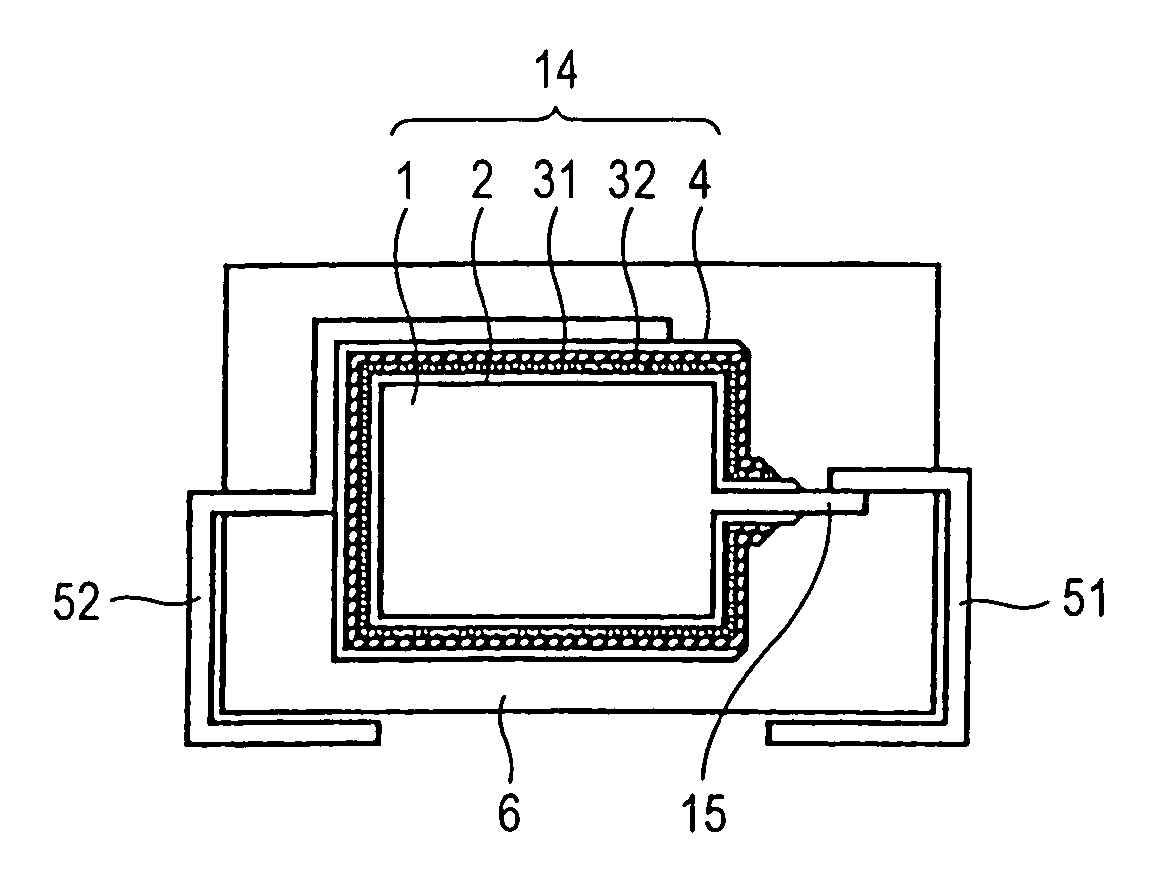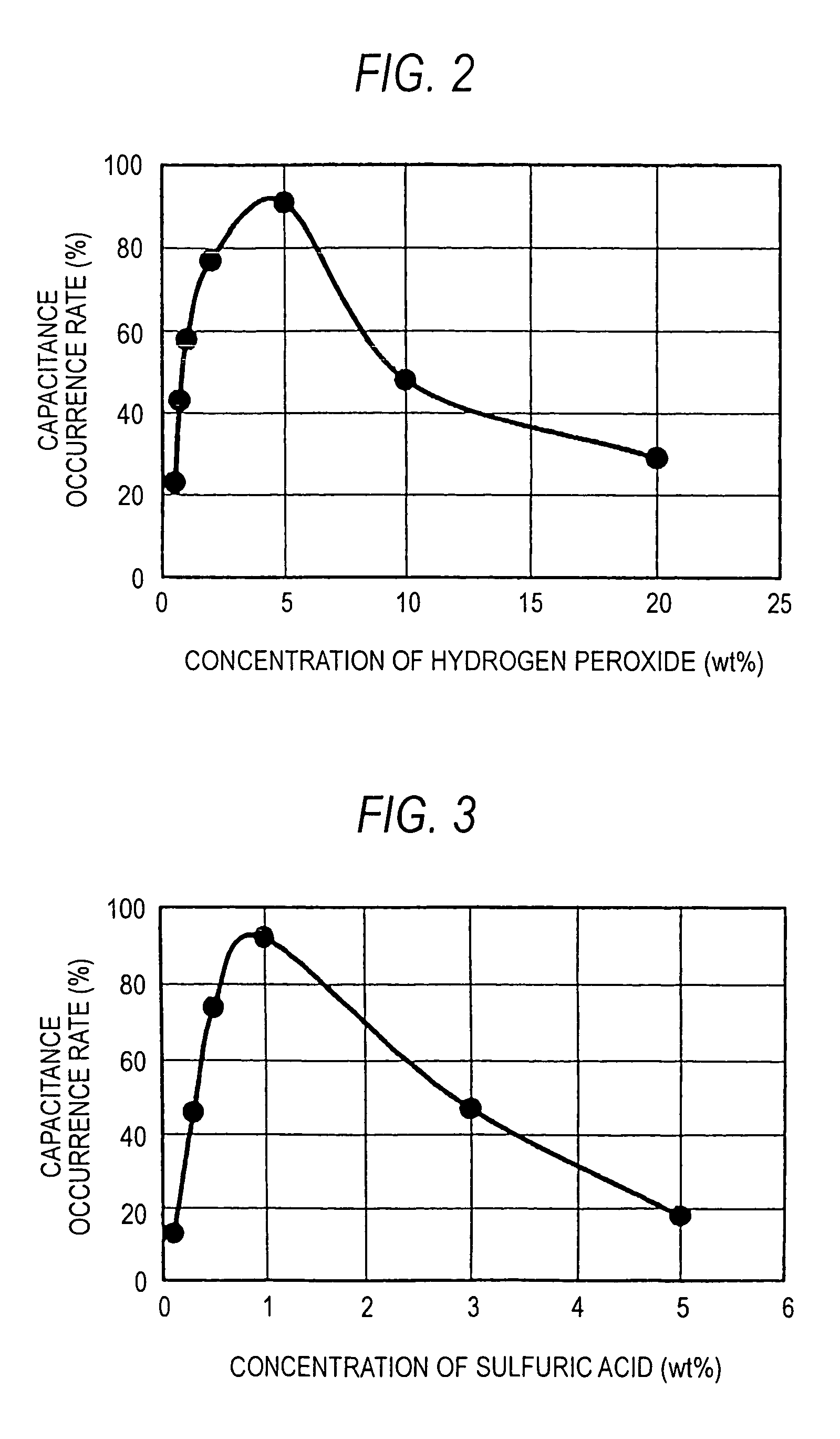Method of producing solid electrolytic capacitor
a solid electrolytic capacitor and electrolytic capacitor technology, applied in the manufacture of electrolytic capacitors, capacitors, electrolytes/absorbents, etc., can solve the problems of inability to overcome, the simple transfer of tantalum electrolytic capacitors' conventional technology is far from manufacturing practically applicable ones, and the leakage current is likely to increase. , to achieve the effect of reducing the leakage current and high capacitance occurrence ra
- Summary
- Abstract
- Description
- Claims
- Application Information
AI Technical Summary
Benefits of technology
Problems solved by technology
Method used
Image
Examples
reference example 2
[0077]Except that in the step of forming the first conductive polymer layer an oxidant solution in which 2.3% or 10% by weight of ammonium persulfate and 2.8% by weight of disodium m-benzenesulfonate were dissolved in water was used, under the conditions the same as that of embodiment 1, 2 kinds of capacitors were prepared.
[0078]The electrical characteristics of the capacitors are shown in Table 5.
[0079]
TABLE 5ConcentrationCapac-of ammoniumElectrostaticitancepersulfatecapacitanceoccurrenceESRLC(% by weight)(μF)rate (%)(mΩ)(μA)Reference2.3768450embodiment 2aReference1014127330embodiment 2b
[0080]Thus, even when the first conductive polymer layer is formed of chemically polymerized polypyrrole, when the formation conditions thereof (components of the oxidant solution in this case) deviate from the technical range of the invention, though the aging can be applied and the leakage current can be reduced, the practically applicable level of the capacitance occurrence rate cannot be obtaine...
reference example 3
[0081]Except that in the step of forming the first conductive polymer, a solution in which 10 g of 3, 4-ethylenedioxythiophene and 16 g of ferric para-toluene sulfonate were dissolved in 74 g of isopropanol was cooled to 5 degree centigrade, a anode element thereon a dielectrics film layer was formed was immersed in the solution followed, after pulling up, by leaving at 25 degree centigrade for 1 hr, and thereby a chemically polymerized polythiophene derivative layer as the first conductive polymer layer was formed, under the conditions the same as that of embodiment 1, a capacitor was prepared.
[0082]The electrostatic capacitance of the capacitor was 85 μF (capacitance occurrence rate: 76%) and the ESR was 75 mΩ; however, as to the leakage current, since it was in an almost short-circuited state, the aging could not be applied.
[0083]Thus, when the first conductive polymer layer is formed of a chemically polymerized polythiophene derivative, though a practically applicable level of t...
reference example 4
[0084]Except that in the step of forming the first conductive polymer layer, under the conditions the same as that in reference embodiment 3, the operation of forming the chemically polymerized polythiophene derivative layer was repeated ten times and the operation for forming the second conductive polymer layer was not carried out, under the conditions the same as that in embodiment 1, a capacitor was prepared.
[0085]The electrostatic capacitance of the capacitor was 50 μF (capacitance occurrence rate: 45%) and the ESR was 800 mΩ; however, as to the leakage current, since it was in an almost short-circuited state, the aging could not be applied.
[0086]Similarly to the case of reference embodiment 3, when a conductive polymer layer that is formed immediately above the dielectrics film layer is formed of a chemically polymerized polythiophene derivative, in view of the aging, it cannot be put into practical use.
PUM
| Property | Measurement | Unit |
|---|---|---|
| electrostatic capacitance | aaaaa | aaaaa |
| electrostatic capacitance | aaaaa | aaaaa |
| electrostatic capacitance | aaaaa | aaaaa |
Abstract
Description
Claims
Application Information
 Login to View More
Login to View More - R&D
- Intellectual Property
- Life Sciences
- Materials
- Tech Scout
- Unparalleled Data Quality
- Higher Quality Content
- 60% Fewer Hallucinations
Browse by: Latest US Patents, China's latest patents, Technical Efficacy Thesaurus, Application Domain, Technology Topic, Popular Technical Reports.
© 2025 PatSnap. All rights reserved.Legal|Privacy policy|Modern Slavery Act Transparency Statement|Sitemap|About US| Contact US: help@patsnap.com



